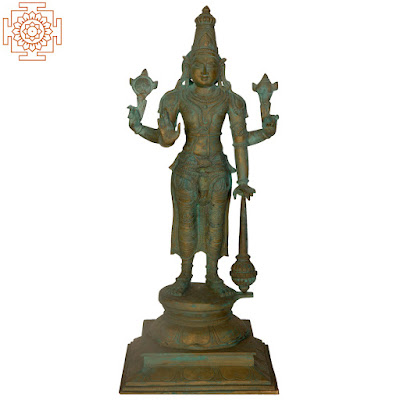According to the Siddhartha-Samhita, there are twenty-four avatars of Lord Vishnu. The Trimurti is a concept in Hinduism in which the cosmic functions of creation, maintenance, and destruction are personified by Brahma the creator, Vishnu the preserver, and Shiva the destroyer or transformer. His four arms indicate his all-powerful and all-pervasive nature. The conch ( Panchajanya) symbolizes that Vishnu is the Divine sound of creation and continuity. The Chakra, "Sudarshana", symbolizes the purified spiritualized mind and represents the destruction of the ego. A mace or Gada, "Kaumodaki" symbolizes that Vishnu's divine power is the source of all spiritual, mental, and physical strength. A lotus or Padma symbolizes that God is the power and source from which the universe and the individual soul emerge.
 |
| Lord Vishnu Lost-Wax Panchaloha Bronze |
Present Bronze Statue of Lord Vishnu from Swamimalai is in Sthanak (standing) posture with chaturbhujaa has a splendid kireetmukuta on the head. Vishnu carries a heavenly chakra "Sudarshana” In one hand and a divine shankha (Panchajanya) in another. Attired in his richly lavish angavastra he is adorned with several scintillating ornaments like necklaces "Kaustubha”( Lakshmi dwells in this jewel, on Vishnu's chest), Urudam, armlets, ear-lobs( Kundals), waist belt ( Kativalay), paadvalay, Paadjalak, and vanamala.
This chaturbhuj Vishnu statue is of the Krisshhan era standing on an attractively carved heightened podium on which is placed the massive mace (Gada) "Kaumodaki” wielded by Vishnu in his left hand. His fourth hand is in blessing mudra, He is gorgeous in his cloudy / sea color with lotus-like eyes & divyangs and the round hola (prabhamandal). This wonderful innovation with incredible carvings must be an essential ingredient of your dwelling.
According to the Shilpa Shastra (an ancient text on Indian iconography), the image of Vishnu is of three types:
1). Sthanaka the standing pose
2). Asana the sitting pose, and
3). Sayana the reclining pose.
Comments
Post a Comment